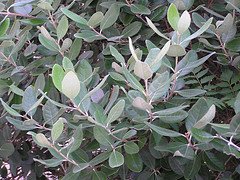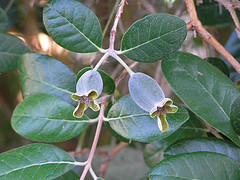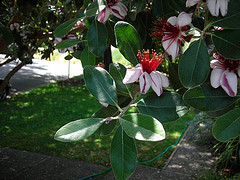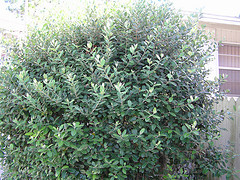|
Acca sellowiana, Feijoa, Pineapple Guava
Acca sellowiana makes a good hedge, and it retains its leaves all winter. The underside of the leaves is silvery white. If unpruned, they can grow to 15 feet around. Feijoas grow best in full sun to part shade, on well drained soil. They are drought tolerant once established. Feijoas are native to subtropical southern Brazil, northern Argentina, Paraguay and Uruguay. The fruits are grown commercially in New Zealand and California.
Try garnishing a salad, dessert or cold beverage with a feijoa flower for an exotic tropical touch.

The egg-shaped fruits are about 2 inches long. Even when ripe, the fruits remain green on the outside, with pale yellowish flesh inside. The sweet aromatic flesh has a grainy texture, like a pear. Fruits ripen in September and October. When perfectly ripe, the fruits fall from the tree. Ripe fruits can be stored in the refrigerator for about a week. The fruits are eaten fresh, or can be used to make preserves or wine.
If you're bored with azaleas, Ligustrums and Nandina, try something different and plant a few Feijoas! back to Evergreen Plants from Acca sellowiana
|
 The feijoa blooms in April and May. The flowers are attractive and edible! They have thick maroon and white petals and red stamens.
The feijoa blooms in April and May. The flowers are attractive and edible! They have thick maroon and white petals and red stamens.  Most feijoa plants are self-sterile and need to be grown with another variety or a seedling in order to produce fruit. Most of the feijoas planted in the landscape are seedlings. Named varieties usually have larger and better quality fruit. Unfortunately, named varieties are difficult to find. A few nurseries in California carry named feijoa varieties such as Coolidge, Mammoth, Nazemetz, Trask and Triumph.
Most feijoa plants are self-sterile and need to be grown with another variety or a seedling in order to produce fruit. Most of the feijoas planted in the landscape are seedlings. Named varieties usually have larger and better quality fruit. Unfortunately, named varieties are difficult to find. A few nurseries in California carry named feijoa varieties such as Coolidge, Mammoth, Nazemetz, Trask and Triumph.